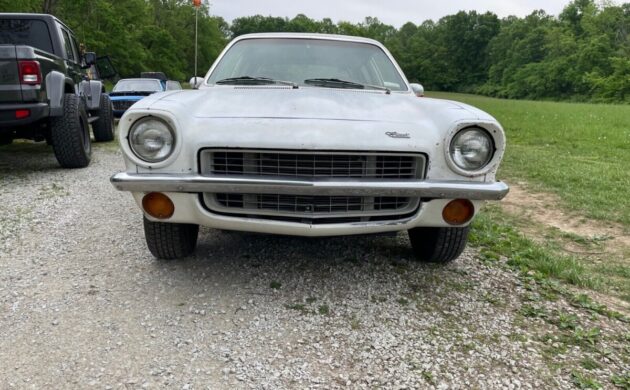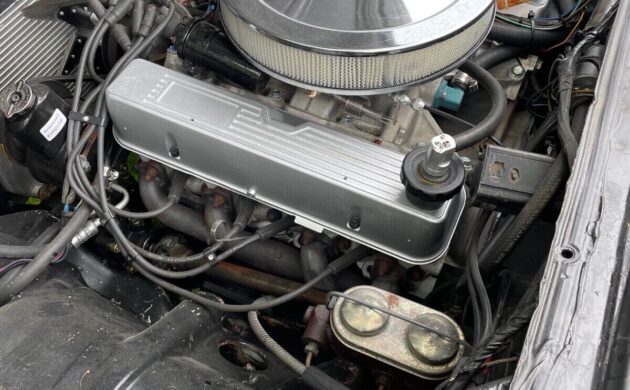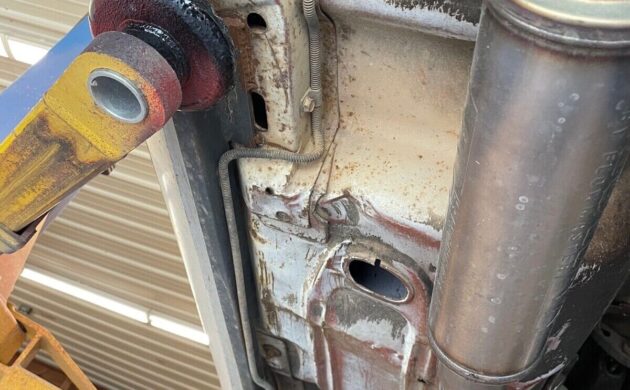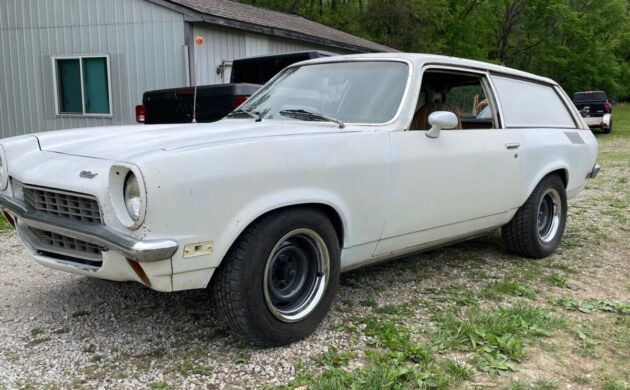The Chevy Vega used to remind me of the body style of the Camaro. This one carries out the illusion—if you keep your eyes on the front clip. When you venture a gaze down the side, everything changes, as this 1971 Chevrolet Vega is a two-door wagon. If that’s your thing, you can see it here on ebay. Where you have until Friday evening to bid. The current number is $3,300 with the reserve not met. The car resides in Nineveh, IN should you secure the win.
You’ll be acquiring a 79,000-mile car, though that number hardly matters when you consider that what resides between the fenders is a modified 3.9-liter V8 sourced from a Rover. There are various relevant details in the ad, including tech specs that show either that the builder is a great experimenter or that he knows how to throw go-fast parts at a car being modified, but the claim that the engine is either from a 1998 or 1999 might give you a bit of pause. Oh, throw 2000 in there also. The car is fitted with Buick engine externals (front cover and oil pump). In any case, this is close to the “V8 in a Pinto” dream scenario of the 1970s, where a person buys an American econobox and then drops a Chevy 350 in it and takes titles in late night street racing drags. And one has to admit that the engine looks pretty cool nestled in there. (No, that’s not a reason to make an outrageous bid. Let the idea settle first.)
This is a California car, which means no rust except surface rust, despite what some images seem to show (just dirt, claims the seller). The thing is, you’re probably going to have to do some sorting. How comfortable are you with the claim that “almost everything that should work on the car does”? That includes a very stiff (racing) clutch and five-speed transmission, along with five-lug wheels. In short, the first thing you’re going to have to do when this lands in your driveway is perform some kind of forensic audit to figure out what you’ve got.
Poking around online to establish value, it’s clear that the Vega has come into its own in terms of selling prices, with cars going in the mid-teens in some cases. But that’s for restored-to-factory examples. Here, what are you buying? One person’s dream? One person’s attempt at a dream? And what do you do when you have to call Summit Racing and order parts to complement parts that you can’t quite identify but think that it’s kinda gotta be . . . . You get the picture. Maybe your local speed shop can help, though, if they have patience and a bit of an adventuring spirit.




I think it’s a neat car. Any information how it drives etc.? That would really help.
The engine has Buick engine externals because it IS a Buick engine, at least it was before they sold the tooling to BMC in the 60s.
I thought that was a Buick 215 cid when I first saw it. BMC solved some of the problems. I once stuffed on into a ’59 Viovo PV544.
Is it an original panel or a wagon? And if it’s the latter do they have the original rear quarter glass?
Originally a panel.
https://barnfinds.com/v8-panel-delivery-1971-chevrolet-vega/
The 3.9 V8 was fitted to TVRs and Range Rovers, amongst others.
This is a first for me a 3.9 V8. Old Buick design engine. It’s really looks good sitting there. I wish it had pictures of the interior. Then we can tell if it was a wagon or panel mini van. After reading the seller write up this still needs work. Not much but it should keep the price down. This is the best 71 Vega I seen in a long time. A fair price for all the work should be.. $12,500.. Good luck to the next owner..🐻🇺🇸
https://barnfinds.com/v8-panel-delivery-1971-chevrolet-vega/2-1760/
Wonder why they used the GM/Rover V8. A small block Chevy bolts into the Vega with a mount kit. Maybe they were going for lighter weight.
Kudo’s to whoever did it.I’d take a real close in person look at it before I bought it to see the build quality.Neat car though.Always liked the early Vega’s with that mini camaro like front end, now if they only could have used today’s metal technology and a dependable engine they would have had a winner.glwts.
When the Vega was introduced in 1971, I fell in love with the wagon. I wanted one but was talked into buying a Pinto wagon…a decision I’ve regretted ever since.
Maybe the fellow that talked you into buying a Pinto was an engineer at the GM diecasting plant in Massena, NY. He or she would have been knowledgeable about the original Vega SOHC I-4 engine which was pressure diecast (not sand cast) A-390 aluminum and had major problems due to uneven cooling of the dies resulting in thermal stress cracks and porosity in the engine block. Attempting to better cool the dies, engineers employed Anviloy 1150, a high conductivity W,Ni,Fe,Mo powder metal material as a replacement for some of the H-13 tool steel die inserts. Unfortunately, the die and block cooling problem was not entirely eliminated.
Once in the engine bay, the disparate cooling of the cast iron head and aluminum block combined with an undersized radiator resulted in head gasket problems and, in some cases, distortion of the cylinder bore causing the engine to become an oil burner.
Whoever talked you out of buying a Vega did you a favor.
That Vega woulda been a bigger regret lol
That engine has also found its way into a number of Corvairs. That little, light weight engine is an easy swap into almost anything.
“Has a 2000 3.9 Rover engine” And we all know how reliable English engines are…a dealbreaker!
Not exactly an English engine, Grandpa. It’s a Buick.
I had one of these engines in my ’63 Buick Skylark, all aluminium 215c.i. w/a factory 4 barrel. Great little motor. GM sold the tooling to British Leyland, I think they should have kept it to use in the fwd Cadillac De Villes instead of the 4100 nightmare. I had one of those too, a whole other story.
There’s much more to this engine than you seem to think.
I like the body choice.
At least you can see his garage area is set up with Tools etc for doing these kinds of things, and one of the pictures in the background you can see another Vega and behind that you can see a Chevy Bel Air it looks like… so he’s a hot rodder himself.
Would definitely want to see some interior pictures though.
Copper brake lines? I don’t think so.
That is a big no no. Copper work hardens, you never use it for brake or fuel lines.. I didn’t look at all the pics on Ebay before I commented …my bad. Now I’m suspicious on the build quality.
That’s not copper, it’s ni-cop. Look it up. Copper coating over nickel steel line. Very easy to form, almost as easy as pure copper but with the strength of steel. It’s used a lot for custom or shop made replacement lines. It’s rated for high pressure use like brake lines. Very safe.
Love the car! Hate the drivetrain choice! I would have to ask “Why?”. Had a 73 with a 350 in it and have regretted getting rid of it every day.
How is the rear axle located ? Cuz the stock set up wasn’t very robust. It couldn’t stand abuse from the 4 cylinder. I can’t imagine a small 8 lasting.
Love the car! Hate the drivetrain choice! Gotta ask “Why?”. I had a 73 with a 350 and I have regretted getting rid of it every day.
Well done little car from what we can see. I still wonder about rust. The little Buick motor is mostly aluminum as I recall (iron heads?). Shouldn’t upset the balance of the car too badly.
I’ve often wondered why some entreprising hot rodder didn’t put one of the GM V6s in one of these.
The 215 V8 had and aluminum block and heads. IIRC that was continued after Buick sold the tooling to British Leyland.
Ok, I think the drive train is the right one for this Dennis, the reason, this is the same as the 215 GM engine that was used in Buick, Olds, and Pontiacs in the early 60’s, all be it this is somewhat larger in displacement the fact that they weight only twenty pounds heavier than the original 4 cylinders and you could get all kinds of high-performance parts to boast HP make the HP to weight ratio way better with this combo, and you have way less front suspension mods to get it to handle well on top of it, that keep overall cost lower, but each to their own. this is a good start to a pretty good sleeper!
Well, blast, Buick used this engine, Olds used the basic engine but used cylinder heads of their own design, but I don’t remember Pontiac using it. Pontiac seemed to depend on V8 of their own and the 4 cyl (sawn in half 389) of their own design. Can anyone else add to this?
Yea, Pontiac offered it in their Tempest in 61 and 62.
The 4 was terrible.
To each his own. I owned one with a 350 so I speak from experience.
That 215 ci aluminum block engine also saw duty in the MGB-V8.
Airplanes too.
MGC……but you are basically correct.
You may not even have to change front springs since the 215 v8 is only
33 lbs heavier than the vega 4 cyl ! – accroding to …
https://www.gomog.com/allmorgan/engineweights2.html
(ck out the wt of the Chevy L6 216/235 lol)